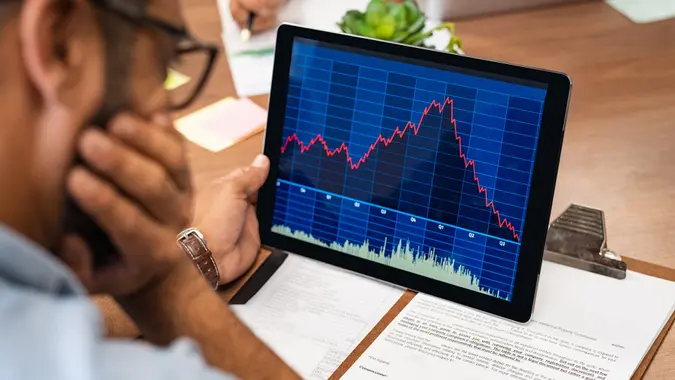What Is Ethereum 2.0? What You Should Know

Commitment to Our Readers
GOBankingRates' editorial team is committed to bringing you unbiased reviews and information. We use data-driven methodologies to evaluate financial products and services - our reviews and ratings are not influenced by advertisers. You can read more about our editorial guidelines and our products and services review methodology.

20 Years
Helping You Live Richer

Reviewed
by Experts

Trusted by
Millions of Readers
Ethereum 2.0 was an upgrade to the Ethereum blockchain. It consisted of three core steps, two of which were completed. The third step was deemed no longer necessary as other technology was developed faster than expected.
This upgrade helped to make the Ethereum ecosystem more scalable, secure and sustainable.
Ethereum 2.0 consisted of three core steps, two of which were completed:
- Launch of the Beacon Chain — complete
- The Ethereum Merge — complete
- Ethereum Sharding — replaced by layer 2 rollups
Step 1: Ethereum Beacon Chain
The addition of the Beacon Chain was the first stage in the upgrades. This was a test to see if the network could handle a proof-of-stake mechanism. Before the upgrade, Ethereum was using a proof-of-work mechanism that was less secure and energy efficient. During this process, the network still relied on the proof-of-work mechanism.
After the Beacon Chain test was successful, it was time for the merge.
Step 2: Ethereum Merge
The Ethereum Merge followed the introduction of the Beacon Chain. It combined the blockchain data that has been collected since Ethereum’s inception with the data collected on the Beacon Chain, creating one mechanism dedicated to the proof-of-stake consensus.
While the proof-of-work still exists, it has been altered so that it’s no longer profitable for miners to use it. Post-Merge, it’s estimated that the amount of energy used for Ethereum decreased by 99.95%.
Step 3: Ethereum Sharding — Layer 2 Rollups
Sharding was the last stage of the update, but it was dropped from the roadmap.
What Is Sharding?
Sharding divides data into smaller subsets, which reduces transaction times and network congestion on the blockchain.
The belief is that increasing data availability removes the need for expensive computing hardware. Therefore, anyone with a regular phone or laptop will be able to contribute to securing the network.
What Are Layer 2 Rollups?
Layer 2 rollups is another scalability tool that was quickly developed. It refers to taking hundreds of transactions completed on layer 2 — a secondary blockchain of Ethereum — and “rolling up” or bundling them into one transaction on layer 1, which is Ethereum’s base blockchain. This process has been able to provide scaling without the step of sharding.
How to Participate in Ethereum
People can participate in Ethereum through staking. This is when you essentially put your Ethereum in a digital vault to help the network validate transactions. Stakers are paid for this. However, you have to have at least 32 ETH to stake.
The Future of Ethereum
People who participate in Ethereum have these goals for the future of the network:
- Cheaper transactions: The current effort to reduce fees is focused on reducing data storage costs through Proto-Danksharding — moving data from Ethereum to temporary storage.
- Extra security: Planned improvements to Ethereum’s security include increasing liquidity, protecting users from spam attacks and from failures in the network, hardware and software.
- Better user experience: Ethereum is aiming to make itself easier to use through protection for lost or stolen wallet keys and making nodes more accessible for the less tech-savvy.
- Future proofing: To keep itself both relevant and reliable, Ethereum is developing upgrades to protect the network from anticipated future threats.
FAQ
Here are some questions people ask about the Ethereum 2.0 upgrades.- What is the difference between Ethereum 1.0 and Ethereum 2.0?
- Ethereum 2.0 runs on proof of stake instead of proof-of-work. This is a more energy efficient and secure mechanism that validates transactions.
- How does Proof of Stake improve Ethereum’s network?
- It uses less energy and adds security to transactions.
- When was Ethereum 2.0 fully launched?
- It was finished in 2022.
- Can I participate in Ethereum 2.0 staking without running a validator node?
- Yes.
- What are the benefits of Ethereum 2.0 for developers?
- It helped create more data availability, which means that people on less powerful devices (think mobile phones) can participate.
Chris Ozarowski and Amber Barkley contributed to the reporting for this article.
Our in-house research team and on-site financial experts work together to create content that’s accurate, impartial, and up to date. We fact-check every single statistic, quote and fact using trusted primary resources to make sure the information we provide is correct. You can learn more about GOBankingRates’ processes and standards in our editorial policy.
- Finder. 2023. "Ethereum (ETH) price prediction 2023."
- Binance. 2022. "What Will Happen to My Ether After Ethereum's Merge?"
- University of Cambridge Judge Business School. "Bitcoin network power demand."
- CoinMarketCap. 2023. "Global Cryptocurrency Charts."
- TheNewsCrypto. 2022. "ETH Merge Will Reduce Global Electricity Consumption by 0.2%."
- Time. 2022. "A Top Ethereum Developer Plays Down the Inevitable Glitches During the Merge."
- Our World in Data. "Argentina: Energy Country Profile."
- Bitcoin.com "What is Ethereum 2.0?"
- Kraken "What is crypto staking and how does it work?"
- Blockpit "How Does Bitcoin Work? Blockchain, Network, Transactions"
 Written by
Written by  Edited by
Edited by 

























